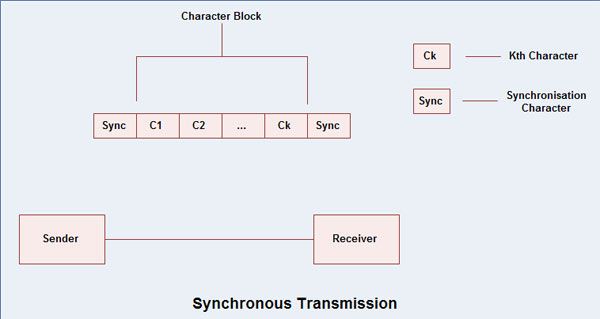Data is transmitted between communication devices in multiples of fixed-length units, typically 8-bits. For example, if the computer is transferring a source program, the data will be made up of a block of 8-bit binary-encoded characters. On the other hand, if the data is in the form of a compiled object code of the program, the data will be made up of a block of 8-bit bytes. At the receiving end, the following parameters are determined to decode and interpret the message correctly.
1. The start of each bit period.
2. The start and end of each character or byte.
3. The start and stop of each complete message block.
These three parameters are known as bit synchronization, character, or byte synchronization, respectively.
In general, there are two transmission modes; they are synchronous and asynchronous modes. In a synchronous mode, the transmitter and the receiver use the same clock. But in an asynchronous mode, two independent clocks are used on either side.
Synchronous mode Asynchronous transmission is used only when the rate at which characters generated is unknown or the transmission data rate is too low. For the transmission of a large block of data at relatively higher bit rates, synchronous transmission is used. In synchronous mode, the sending and receiving devices are synchronized with a common clock signal. This eliminates the need for the start and stop bits. The complete block of data is transmitted with fixed time interval between the bits. Before the start of transmission, clocks at both ends are to be synchronized. This is achieved by sending special character bytes called sync bytes or sync characters between the sender and the receiver. The sender informs the receiver about the start of a block. The receiver figures out the start of each character by knowing the coding scheme used. If the sender is idle or does not transmit any character, the receiver searches for the next group of sync characters. The devices are then resynchronized to receive the next block of characters. The block length varies from few bytes to many hundreds of bytes. The most commonly used protocol is the BISYNC or Bit Synchronous Protocol.
 Asynchronous mode Asynchronous mode is also known as start-stop mode. This mode is used when data to be transmitted is generated at random intervals. For example, when a user communicates with a computer using a keyboard, the time interval between two successive keystrokes is random. This means that the signal on the transmission line will be in idle state for a long time interval between characters. With this type of communication, the receiver must be able to resynchronize at the start of each new character received. To accomplish this, each transmitted character or byte is encapsulated between an additional start bit and one or more stop bits. This mode is mainly used for the transmission of characters between a keyboard and a computer. Asynchronous transmission can also be used for the transmission of a block of characters or bytes between two computers. The time interval between successive characters is a variable entity.
Asynchronous mode Asynchronous mode is also known as start-stop mode. This mode is used when data to be transmitted is generated at random intervals. For example, when a user communicates with a computer using a keyboard, the time interval between two successive keystrokes is random. This means that the signal on the transmission line will be in idle state for a long time interval between characters. With this type of communication, the receiver must be able to resynchronize at the start of each new character received. To accomplish this, each transmitted character or byte is encapsulated between an additional start bit and one or more stop bits. This mode is mainly used for the transmission of characters between a keyboard and a computer. Asynchronous transmission can also be used for the transmission of a block of characters or bytes between two computers. The time interval between successive characters is a variable entity.

 Dinesh Thakur holds an B.C.A, MCDBA, MCSD certifications. Dinesh authors the hugely popular
Dinesh Thakur holds an B.C.A, MCDBA, MCSD certifications. Dinesh authors the hugely popular